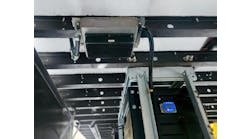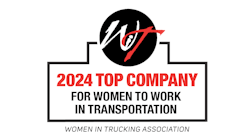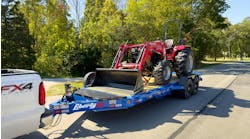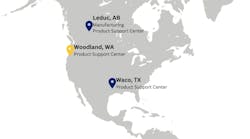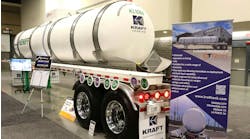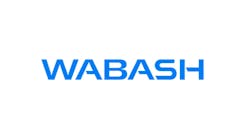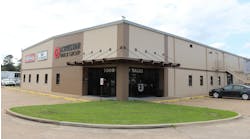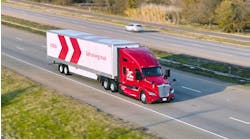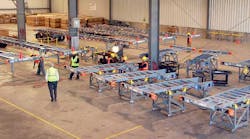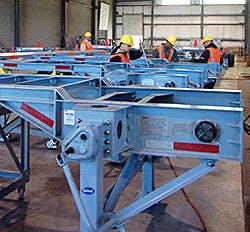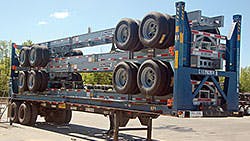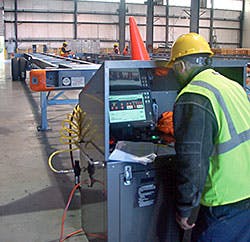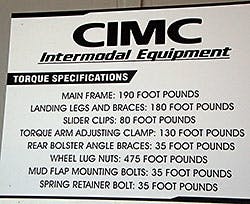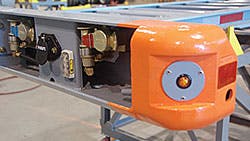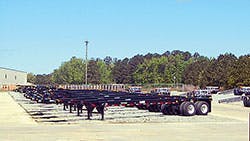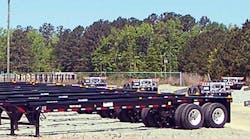NORTH AMERICA is a massive market that generates immense volumes of freight.
According to the US Commerce Department, the United States spent $1.33 trillion on logistics and transportation in 2012. This represents roughly 8.5% of the country’s annual gross domestic product.
Every year, nearly 25 million containers and trailers are moved using intermodal transportation, according to the Intermodal Association of North America. Electronics, mail, food, paper products, clothes, appliances, textiles and auto parts are just some of the goods that travel inside ISO and domestic. Container chassis play a key role in getting those goods to and from the port.
CIMC Intermodal Equipment has been producing container chassis at a plant in South Gate, California, since 2006. That enabled the company to serve West Coast markets.
But to fully serve the intermodal market, the company decided it needed to have a second production facility on the East Coast. That need officially was met earlier this year when CIMC opened a container chassis plant in Emporia, Virginia.
Emporia is centrally located, putting it within easy reach of most major East Coast ports. The plant is less than 500 miles to New York and Newark to the north and 530 miles to Jacksonville to the south, putting the plant within a 500-mile radius of the top four ports along the East Coast and the vast majority of the container freight as measured by twenty foot equivalent units.
Management appreciated the value of the location. The first choice was Norfolk, one of the busiest ports on the East Coast. But when no suitable location could be found, CIMC began looking inland. Emporia, some 90 miles from the coast, also is centrally located and just as convenient from a shipping standpoint, says Buzz Hagen, CEO of CIMC Intermodal Equipment.
“If we were manufacturing in Norfolk, just about every shipping container that we built would have to travel north or south along Interstate 95,” he says. “And to get our chassis from Norfolk to Interstate 95, we would use U S Highway 58. Emporia is where U S 58 intersects Interstate 95.”
Getting started
In addition to the benefits of its location, the site CIMC selected for its East Coast operation was well suited for a container chassis operation. The site has 10 acres of concrete parking that the plant can use for storing completed product. In total, CIMC has 29 acres in an industrial park.
CIMC Intermodal Equipment has a five-year lease on the property with an option to buy at a preset price.
CIMC got the keys to the building January 10 and started production three months later. It was a very busy three months. In addition to staffing training personnel, the facility presented major challenges. The site was formerly the home of a concrete culvert manufacturer. The building had been vacant for three years, but the hardened concrete and debris generated by the concrete mixing and pouring process made the building an obvious candidate for some deep cleaning.
Once the dust and residual concrete from the mixing operation was removed, the pits inside the plant were filled, and the yard was cleared of left-behind concrete culverts, it was time to prepare the plant for container chassis production.
“We got the building set up in about three months, including training personnel and installing jigs and fixtures,” Hagen says. “With the exception of a forklift that we brought in from California, everything is new.”
Two things helped the process go so quickly. First, the Emporia operation essentially is a clone (albeit on a somewhat smaller scale) of the way CIMC has been producing container chassis in California. Second is the nature of the operation.
The Emporia plant, like its sister facility in California, assembles container chassis instead of fabricating them. The chassis frame—built in China as a series of subassemblies—bolts together with Grade 9 bolt. From there, it is a matter of equipping the chassis with components that the company sources locally. That would include wheels, tires, axles, suspensions, and electrical components.
State of the market
CIMC Intermodal Equipment is serving a market that has changed significantly in recent years, Hagen says.
“Shippers have divested their chassis,” he says. “There has been a big switch to private ownership.
Port congestion also has been an issue recently.
“Everyone is pointing to a shortage of chassis,” Hagen says. “The truth is that we have a fairly large fleet of chassis, but many of them are 25 years old.”
In today’s environment, with the Federal Motor Carrier Safety Administrations recently implemented CSA (Compliance, Safety, Accountability) program in effect, 25-year-old container chassis have become far less desirable.
“Companies want to have good maintenance scores, and operating old equipment makes that more difficult,” Hagen says. “The market is transitioning to newer chassis, and people want to own them.”
Purchasing Direct
CIMC Intermodal Equipment originally was formed as Direct Chassis LLC in 2004. Four years later, CIMC bought 60% of the Kingwood, Texas based company.
In 2011, CIMC moved to acquire 100% of the company. Direct Chassis LLC became part of CIMC USA. CIMC USA also includes Vanguard National and CIMC Reefer Trailer.
Hagen, CEO of CIMC Intermodal Equipment, has seen service in other CIMC operations, including the CIMC refrigerated trailer plant in Qingdao, China, a facility that he helped get started.
CIMC USA has grown significantly since the launch of Vanguard National in Monon, Indiana, more than a decade ago. In a sense, the formula at Vanguard is similar to that employed at CIMC Intermodal Equipment. CIMC produces steel components in China, ships them to U S facilities. There those steel pieces are combined with domestically sourced trailer components to produce trailers and chassis engineered specifically for the North American market.
“CIMC USA employs 800 people in the US,” Hagen says. “These are solid manufacturing jobs that contribute to our economy.”
